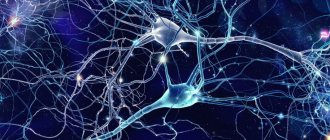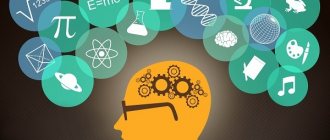The main role of associations in memorization is that we link new knowledge to information we already know. To build a good association, you need to know some useful criteria for finding connections between things, as well as develop your associative thinking and creative imagination. It is equally important to learn how to build associative series and connections to stimulate figurative memory.
This lesson will show you how to use the association method to remember information.
The story of how Mikhail developed his memory
Since my school days I have had a friend, Mikhail, whose memory has always amazed me. He could easily remember a poem or a mathematical formula. Years later, having entered the university, his abilities were not lost, but only increased.
I wondered how he was able to achieve such results. The secret turned out to be simple - he uses various exercises to develop his brain abilities. It turned out that daily training, even the shortest, can lead to excellent results.
Since then, I have also become interested in developing my own capabilities, which has resulted in some good success. This article will help everyone who wants to develop their associative memory.
Psychoanalytic theory
Representatives of the psychoanalytic theory of memory, the founder of which is Z.
Freud, special attention in considering the preservation and memorization of information is paid to the unconscious level of the psyche. The psychoanalytic theory of memory shows the significant role played by early emotional experiences that can influence the rest of life.
Representatives of this theory pay special attention to the displacement of negative information from consciousness and its manifestation through humor, dreams, slips of the tongue and other manifestations of the unconscious.
Thanks to psychoanalysis, many interesting psychological mechanisms of subconscious forgetting related to the functioning of motivation have been discovered and described.
What is associative memory
Associative memory is a certain connection between ideas and the circumstances that have occurred. Associative memory has been studied by science for quite some time. In the course of time and its changes, basic principles were created. These are called principles of association, well used in the field of psychology. They are presented in 3 groups:
- Adjacency associations. Images saved at some point in life evoke memories in us. Depending on the events that occurred, the nature of the memories depends on whether they will be positive or negative.
- Associations by similarity. An example would be a photograph or painting that evokes a resemblance to a person’s face or a place that is vividly remembered.
- Associations by contrast. Memorized objects or moments of life can evoke opposite images in the mind.
In order to better remember a certain material or event, a person needs to select an association that will be associated with the remembered phenomenon. Using them will help you fully reproduce important details at the right time. It doesn't take much effort to create an association. This process is more creative than mental. For a person to easily remember an association, it must be simple, unusual and detailed.
Different moments can be deposited in memory and stored for a long time not separately, but in the form of a logical chain of related events. Basically, one memory leads to others. In addition, experts have found that human associative memory stores information selectively. This does not happen consciously. The brain itself filters information and, with the help of modifications or transformation, puts aside what a person remembers. This can easily be explained by the fact that we either cannot remember a basic event or we reproduce some insignificant fact in great detail.
Types
They are distinguished by:
- similarities: sled – skis – snowboard.
- contrast: white - black, boy - girl.
- the relationship between the whole and its parts: finger - nail, phone - screen.
- cause-and-effect relationship: clouds - rain, fire - fire.
- generalization: shoes are footwear, earrings are decoration.
- subordination: watermelon - berry, maple - tree.
- contiguity of space or time: winter - cold, newspaper - magazine.
- addition: butter - salad, soup - bread.
How does it affect the development of human abilities?
Associative memory is considered a fairly effective method for learning new material. Scientists have proven that it is easier to remember material filled with meaning than a meaningless set of words. Therefore, the data being studied must be divided into blocks and associations created for them.
This process allows you to assimilate the necessary information, create a logical chain, and the user can easily reproduce the desired text in the future.
Using associative memory, a person develops the following abilities:
- remembers a large amount of information;
- helps create new ideas;
- develops memory;
- stimulates the development of imagination;
- improves the process of remembering new things.
In cases where a person urgently needs to remember complex material, an association can be made with an already familiar image or object. In this way, interconnected data is much easier to perceive and store in memory. This process helps connect new knowledge to existing knowledge. This has a good effect on the development of human abilities.
Industry Standards for Content Addressable Memory
The definition of the primary interface for NSEs and other Network Search Elements (NSEs) was specified in an Interoperability Agreement called the Look-Aside Interface ( LA-1
and
LA-1B
), which was developed by the Network Processing Forum, which was later merged with the Optical Internetworking Forum (OIF).
Numerous devices have been manufactured by Integrated Device Technology, Cypress Semiconductor, IBM, Netlogic Micro Systems and others under these LA agreements. On December 11, 2007, OIF issued a Serial Lookaside Agreement ( SLA
).
Exercises to develop associative memory
Thinking through associations is the basis for the creative activity of every person. It is not only possible, but also necessary to develop this ability. This kind of thinking develops best in children, because their heads are not filled with everyday problems, but like a sponge they absorb everything new and interesting. Children's imagination works much better than adults'. They create unusual and interesting associations with words, which helps develop the child’s creativity.
Adults can also develop associative memory. There are a number of exercises for this:
What's the benefit?
We need this type of thinking to solve problems, both life and work. And if you engage in its development, pleasant bonuses will await you. For example:
- Improving imagination. Accordingly, you will be able to generate creative ideas, it will be easier for you to meditate and, in general, be creative.
- Strengthening memory. You will remember the material better, since with the help of the created associative series it is quite difficult to forget something.
- Increased productivity. Given the fact that your cognitive processes will become better, you will perform work faster and better.
- Brain stimulation. When an associative series is formed, the brain goes into action, forming new neural connections.
- Ease of perception. It will be easier to perceive new information and adapt to changes.
- Personality research. Even Sigmund Freud, a well-known psychoanalyst, used associations to study what is in a person’s subconscious. In general, you will receive information about yourself that will most likely help you change your quality of life, find answers to important questions and solve complex life problems, and unleash your creative potential.
Many inventions were created thanks to associations. For example, Georges de Mestral came up with the idea of Velcro fasteners after once examining burdock spines under a microscope. He constantly removed them from the fur of his beloved dog after walks. Seeing how interestingly the hooks of this plant were arranged, he had the idea to create such a valuable piece of clothing, shoes, and accessories.
Gestalt theory of memory
After the associative theory encountered a problem that it could not answer (we are talking about explaining the selectivity of memory), it was replaced by another theory - Gestalt. The initial concept in this teaching was the original, integrity of the primary elements - gestalt. Proponents of this theory are convinced that it is the principles of gestalt formation that determine human memory.
This concept emphasized the importance of the fact that material to be memorized and reproduced by a person must be structured, brought to integrity and organized into a system
Particular attention was also paid to the role of human intentions and needs; by the way, this is what representatives of Gestalt theory explained the selectivity of mnemonic processes. The main idea of its adherents is that the material (both when memorizing and reproducing) is an integral structure, and not a random set of elements formed on an associative basis
Gestalt theorists explain the dynamics of memorization and reproduction as follows: at each individual moment in time, a person has a certain need that contributes to the creation of an attitude towards memorization or reproduction. The installation, in turn, animates the necessary integral structures, which are the basis for memorizing or reproducing the material.
Despite the fact that representatives of this theory found psychological explanations for many facts of memory selectivity, they were unable to solve the problem of the formation and development of human memory in phylo- and ontogenesis. Motivational states that determine mnemonic processes in humans are predetermined - this is exactly how representatives of the Gestalt theory of memory imagined memorization. Briefly, the shortcoming of this doctrine can be expressed as follows: it did not pose and did not try to resolve the issue of the dependence of the development of a person’s memory on his practical activity.
Correction of memory impairments
In many cases, human memory impairments and disorders can be corrected and treated with medication if treated in a timely manner. Methods of correction depend on the type of memory impairment; in case of particularly severe ones, one should not hope for a cure, only for the relief of concomitant symptoms. The main treatment regimen is based on the following therapy:
- relief of an acute condition (for psychosis, trauma);
- vitamin therapy;
- psychotropic drugs (tranquilizers Elenium, diazepam);
- restoration of cerebral circulation (Nootropil, Vinpocetine, Piracetam, Gingko Biloba).
In addition to treatment, the following are prescribed:
- balanced diet;
- herbal medicine (sage, ginger, infusion of motherwort or valerian officinalis);
- Cognitive development of memory helps keep it in good shape until old age (new hobbies, solving crosswords, learning foreign languages).
Bibliography
- Kohonen T. Associative storage devices. M.: Mir, 1982. - 384 p.
In English
- Anargyros Krikelis, Charles C. Weems (editors) (1997) Associative Processing and Processors
, IEEE Computer Science Press. ISBN 0-8186-7661-2 - Pagiamtis, K. & Sheikholeslami, A. (2006, March). [www.pagiamtzis.com/pubs/pagiamtzis-jssc2006.pdf Content-Addressable Memory (CAM) Circuits and Architectures: A Tutorial and Survey.] IEEE J. of Solid-State Circuits
, 41(3), 712–727. - [patft.uspto.gov/netahtml/PTO/search-bool.html Hannum et al. (2004) System and method for resetting and initializing a fully associative array to a known state at power on or through machine specific state
]. US Patent 6,823,434.
LiveInternetLiveInternet
Associative thinking is extremely important! It is characteristic of creative and witty people. In this article, we will briefly examine the phenomenon of this thinking itself, and also provide simple and effective exercises for its development, designed for a single user. So let's start from the beginning. What is associative thinking anyway? Associative thinking is thinking based on associations. This type of thinking is an important part of the information processing mind that makes generalization and abstraction possible without any logical analysis. What is an association? Simply put, this is a kind of connection between individual ideas, when one of them entails the appearance of another. Any person uses associations in his thinking. For example, we smell a pie and remember the old village house in which we spent our childhood. When we pronounce the word “lemon,” we can notice how saliva is released. Or someone tells us “forest”, and the image of a spruce pops up in our minds. All this is determined by the associative connection of mental phenomena (elements) in our psyche.
Usually four classes of associations are distinguished: 1. by contiguity in time or space: house - brick, car - steering wheel, mouth - teeth; 2. by similarity (similarity): street lamp - kerosene lamp, lighter - match; 3. by contrast (opposite in properties): father - mother, good - evil, life - death; 4. cause-and-effect: lightning - thunder.
Using the law of associations can be useful in solving various problems. Association connects the original task with similar features of other objects: images and symbols, memories, smells, sounds, sensations, etc. It is known that the solution of many problems is hampered by a limited circle of associations. If we pay attention to the history of science, we will see that it was they who helped make a number of different discoveries. For example: • The impetus for the Scotsman Dunlon's invention of rubber tires was the observation of a springy hose; • Bridge engineer Brown invented a suspension bridge using cables and chains when he somehow found himself under a bush and saw a spider’s web; • Japanese physicist H. Nagaoka proposed a structure resembling the solar system when scientists were trying to understand the place of subatomic particles in the atom. Thus, developed associative thinking can help: • create new original ideas; • create meaningful connections; • stimulate the imagination.
A special word should be said about improving memorization and recall. The developer of mind map technology, Tony Buzan, writes in his book “Super Memory”: “If you want to remember something new, you just need to correlate it (find an associative connection) with some already known fact, calling on your imagination” Indeed, we better remember those facts that are connected with each other and with the information we already have. And in order to remember something, we just need to connect different facts into a single whole. Well, I hope that now you have enough motivation to develop associative thinking. Let's move on to the more practical part.
It is known that expanding the range of associations can be achieved through targeted training. Below we offer you several simple exercises: Exercise 1. Drawing up chains of associations. We start a chain of associations with a word, then write down (or pronounce) the next word that arises by association. For example: bus - stop - sidewalk - pedestrian - shoes - store - sign, etc. Associations, accordingly, will be different for each person.
Exercise 2. Search for a chain of associations. We choose two words. Next, we look for a chain of image words that begins with the first selected word and ends with the second. For example, there are two source words: stump and pencil. Let's make a chain: stump - tree - paper - pencil. Or: hay and a piano. Chain: hay - scythe - death - coffin - church - church - organ - piano - grand piano. Exercise 3. Combination by attribute. They select two or three words, then select other words to match them that combine with the original ones on any basis (with one or more at once). For example, there are two words: black, hard. Associations based on: coal, nail, oak, marble, etc. Exercise 4. Appropriate words. Two to four words are named, and it is proposed to select words that would fit each original word at the same time. For example, search words: sink, faucet, curtain. Suitable words: toilet, bath, sauna, bathhouse. Or the original ones: tree, lake, lawn. Suitable: estate, garden, resort, etc.
Exercise 5. Unusual associations. The “stimulating” word is used to name unusual words, images or phrases based on distant (“non-banal”) associations. For example, the search word is fishing rod. A banal association is a fisherman. But, say, remembering the fairy tale about a goldfish, the saying “you can’t take a fish out of a pond without difficulty,” or the movie “Titanic” will be more interesting. Each time the training will become easier, and diving into the depths of the sea of your own associations will be more exciting. So train and create for your health. And remember - the main thing is not to be lazy. exercises from the creativity training kit
This is not strictly a group exercise; it can be done in pairs or even alone. To perform exercises to develop associative thinking, it is advisable to have a voice recorder and a notepad with a pen on hand for subsequent decoding and analysis of the sound recording. You should not rely on memory when performing such exercises. Exercises. Working with a chain of associations, akin to dream analysis. And everyone knows: a dream needs to be written down without delay if you don’t want to immediately forget 70% of its details. It's the same with associations.
I suggest doing three simple exercises that help develop associative thinking in those who do them fairly regularly. So, let's start with the simplest thing - the preparatory exercise. I recommend starting any intellectual workout with it. Exercise for the development of associative thinking No. 1 It consists of two equal parts. In the first part we play related associations. In the second part - into unrelated associations.
Related associations The presenter asks the word. This word should (preferably) be a common noun in the nominative case. Then, in a circle, each player (or you alone) continues the chain of associations under a dictaphone recording - that is, he names another word that is clearly associatively connected with the previous one.
Example: • travel, • carriage, • ticket, • conductor, • suitcase, • passenger, • fellow traveler, • view, • window, • station...
In the next round of the game we play Unrelated Associations Example: • travel, • expense, • sunset, • bombing, • polyethylene, • mask, • child, • horror, • collar
In both the first and second cases, after the end of the game, sharing occurs, an exchange of opinions, which is mandatory for any psychological games. During sharing, each participant in the game must explain how and why he decided that it was appropriate to continue the chain of associations (sometimes strictly connected, but especially blurred) with his word. For example, I said “View” after “fellow traveler” because I probably don’t want to look at people, I would prefer to admire the view from the window. I said “fellow traveler” after “passenger” because I wanted to clarify that I am on the same path as this person, we are going in the same direction. I said “polyethylene” after “bombing” because “bombing” implies corpses, and corpses (in my opinion) are wrapped in plastic. I said “collar” after “horror” because I feel horror when something is strangling me, and the collar has the ability to “strangle”.
During sharing, those very “psychotherapeutic insights” occur, during which the players have an epiphany - an understanding of their situation, as well as the release of negative emotions and fears. Exercise for the development of associative thinking No. 2 “Runaway association” The presenter calls a word. For example, "wardrobe". Within five minutes, each player must write down in his personal notebook a chain of associations evoked by this word. The goal is to let go of your thought, allowing it to jump from one association to another.
For example: Wardrobe, • skeleton, • pharmacy, • scales, • sky, • rocket, • cartoon, • childhood, • Romania, • diamond, • jack, • pudding, • hills... During sharing, each player must explain (briefly) your associations. (This explanation is recorded on a voice recorder.) Exercise for the development of associative thinking No. 3 “Strapped association” The presenter asks the word and gives the task: for five minutes, try to keep your thoughts on this image (without being distracted by other topics and images). Then the Presenter turns on the song composition. While the song is playing, each participant must keep the given word in memory.
In order to do this (not to forget a word and not to be distracted by thoughts on other objects and topics), we turn on our imagination and create a whole plot in our thoughts, which helps us stay in the field of a given image. We write down the main moves of this plot in a notebook. After time has passed, each player tells the story that was born in his head, which helped him focus on this word. The host and other players at the time of sharing can ask leading questions, provoke, disagree, or vice versa, agree, supporting the player.
Good luck with your association games, friends! Develop your thinking. Elena Nazarenko © www.live-and-learn.ru
topic of thinking on Wikipedia. On the topic of thinking, you can read the following materials: • Positive thinking as I understand it • Hands off my idea! • How to do your own personal auto-training • Hexagram No. 26 “Taming the Dragon” • “Friends, buy cigarettes!” or A Word about Waldorf pedagogy Tags: associative thinking, exercise for the development of associative thinking, development of associative thinking, associations, creativity training, psychology Methods for developing associative thinking Neretnieks A.A. Riga. The solution of many problems is hampered by a limited circle of associations. At first glance, everyone uses the same circle that he has collected throughout his life. However, in reality a person uses only a small part of his stock of knowledge. The history of science shows that it was associations that helped make a number of significant discoveries. Example 1: Still trying to find “harmony,” Kepler turns to music. He is confident that harmonic proportions are the basis for the placement of planets [2, pp. 65-66]. Example 2: Bohr's father, a professor of physiology, gathered friends at his place and discussed with them issues of the body's problems. Discoveries in the morphology of the organism, the invention of the microscope, etc. confirmed the idea that the body can be considered as a complex machine. But Aristotle already argued in favor of the fact that the organism lives as a single whole, and not as a mechanism (in particular, the ability to adapt to different conditions). This determined the main direction of Bohr’s thinking throughout his life - that there can be two mutually exclusive approaches to the same issue, which are equally necessary.) [2, p. 152-153]. Example 3: In 1904, as scientists were trying to understand the place of newly discovered subatomic particles in the atom, a Japanese physicist named H. Nagaoka proposed the existence of a structure that would in some way resemble the solar system. [1, p. 80]. To eliminate the problem of a limited range of associations, training in associative thinking is necessary. Ideally, a person should instantly find the right association at the right moment, even if he did not suspect that he had such an association. It’s even better if a person knows how to constantly expand the circle of his associations. Then the necessary associations will always be there, all that remains is to take them from the right “shelf”. Exercises for the development of associative thinking can be divided into three categories - freeing thinking, expanding the circle of associations and directing thinking. As in sports, training such thinking requires a kind of “warm-up”, general training and, finally, special exercises for this sport. In our case, the “athlete” must master all types of this “sport”. The above exercises were practiced with students from the International Higher School of Practical Psychology (SPPA), the Riga International Higher School of Economics and Business Administration (RSEBAA) and the University of Latvia (LU). 1. Freeing your thinking This group of exercises at the initial stage of training takes up most of the training. Later it will be reduced to “warm-up”. The task of this group is to help students free themselves from basic stereotypes and clichés, from standard, template thinking. Examples of tasks: • In the group there is a conversation between the students themselves. Any question is asked. The answer must be completely illogical. For example: “What is your name? – The sun is shining outside”, “Which dish do you like best? - Everything is fine!" • The first student names or shows any color. The second should name any color that comes to mind. It can be a different tone of the same color or the opposite color. It is better, however, if the colors are completely unrelated to each other. For example: “Cyan is dark brown, magenta is dirty gray.” It’s even better to provide answers with epithets, for example: “black, like the darkness of a cellar” or “green, like young shoots.” These associations should not be based on any logic, but only on the most imaginative thinking. • One of the students looks out the window and names any object he sees. The second one names the first thing that comes to his mind in this regard. • Students “talk” to each other using newly invented words, the meaning of which no one in the group knows. When forming such words, you cannot use words or parts of words from languages known to the learner. The interlocutor does not need to understand what the other person is talking about. (“Bart Kurman zarashupil zo pazli. – Lo, dern groplis chungli darakvast!” The task is to maintain a “conversation” for as long as possible. Although this exercise seems simple, it requires serious effort. The task of the exercise is to free thinking from ordinary restrictions. 2. Expanding the circle of associations The task of this group of exercises is to expand thinking, but not by changing existing ideas, but by creating new ones.The goal of these exercises will be achieved if associations appear freely, but with a certain amount of logic - so that between associations you can It was necessary to form some kind of logical chain. For example, for the association “sea - dog” the chain could be like this: “grandmother lives near the sea - her neighbor has a dog - this dog often runs to swim in the sea." Examples of tasks: • The simplest exercise . A word is called, the student must name any association for this word. You need to answer quickly, without much thought. Later, the exercise can be supplemented by restoring the chain of associations. • Modification of the previous exercise: a word is called, and the learner must name any word that is not associated with the named one. Later, the exercise can be supplemented with the requirement to still find a chain of associations. • A word is called, the student must name another word that begins with the same letter (the same syllable, or ends with the same letter, syllable). (“Grandma is a badger,” “baby is a stick.”) • A word is called, the student must name another word that begins with the same letter (with the same syllable, or ends with the same letter, syllable). Then he must name the association for the word just named. The next student must name a word with the same letter and an association for this word, etc. (“Grandma – badger – Fur – mask.”) • If in the previous exercises nouns should be named, now you can supplement the exercise with verbs, adjectives or numerals. (“fly – breathe (air) – bird, freedom.” “5 – five-star hotel, 5 fingers”).
• A geographical entity is called – country, city, etc. The student must name the association associated with this object for him. (“Rio de Janeiro – white pants.”) • Any specific professional term unknown to the learner is called. The learner must say what this term might mean. (“A seismograph is some kind of medieval graph.”) • Individually name 10 words for each student. For each word, the student must draw his own association. Then the students exchange sheets of paper, and everyone must say what associations they have with these drawings.
• A color is named or shown. The student must name the object, phenomenon or field of activity with which this color is associated. (“Yellow is a caravan.”) • Associations between sensations – vision, hearing, taste, smell, touch. For example, play a sound and ask them to name what color (taste, smell) it is associated with. Let them touch an object with their eyes closed and ask them to characterize the appearance, color and taste of this object. 3. Guiding thinking This is the last group of exercises that is most important for creating the necessary associations. Its goal is to teach you to feel the system of necessary associations, but at the same time not limit yourself to this system. During training, trainees are given specific tasks that need to be solved from various points of view. In this way, students over time learn to reason from the perspective of various professions, nationalities, social classes, religions, and other human groups. This does not mean that the learner will limit himself to these groups. He will simply learn to apply the right associations at the right moment. Examples of tasks: • Each group member is given a profession (doctor, politician, scientist, artist, etc.). The teacher names the topic and the problem associated with it (for example, an ultimatum from aliens to eliminate all electrical equipment on Earth within a week). Each participant must “philosophize” about solving this problem from the perspective of “their” profession. • Professions are played or given away. The more unfamiliar the profession is to the students, the better. In two or three words you need to explain what this specialist does. A real task is given (improving traffic flow, new energy sources, high incidence of people in winter, etc.). you need to consider what a representative of this profession can offer. Everyone can “invent” for themselves the tools and devices necessary to solve a problem that are appropriate to their profession.
• If the previous exercise is difficult, you can make it easier first. Professions that are more familiar to the trainees are chosen. This somewhat limits the imagination, but even here you can “philosophize.” The problems proposed are similar to the previous ones.
• The teacher sets a problem or phenomenon (how to eliminate the fact that objects sink, float, fall, how to deal with the onset of darkness, etc.) The student must come up with a profession that studies or solves this problem. Including the name of the profession, study methods, etc. First, you need to do this for a minute to eliminate the “philosophizing.” Then you can increase the time to make the decisions more realistic. • As a longer task or even homework, suggest studying the specifics, terminology, etc. any profession. And solve any problem (including in impossible ways). • Exercise with social strata. Similar to the previous exercises, the problem should be solved from the point of view of different social strata. • Exercise with national characteristics. “Nationalities” are played out or assigned. The task is based on stereotypical ideas about national characteristics (Russians like to drink, Latvians quarrel among themselves, Jews bargain, Estonians are slow, Americans boast, Germans are pedantic, etc.) The problem should be solved from these positions.
• Exercise with literary characters. Characters from literature or cinema are played out or set (Frodo, Kashchei, Doctor No, Little Red Riding Hood, Harry Potter, etc.). The problem must be solved from the perspective of these characters and the tools available to them. In addition to these exercises, students should take advantage of every opportunity to independently develop associative thinking. Public transport is ideal for this. For example: • Observe people in transport and, in accordance with stereotypes, determine their age, occupation, nationality, hobbies, etc.
• Observe advertisements outside the window, randomly read words or seen images and name the associations that arise. Practice has shown that after even a short course (two academic hours a week for a semester), the range of freely used associations and their controllability significantly expands.
Memory training
Memory needs to be trained, like any human skill. Our brain holds tens, hundreds of times more information than a computer, but to unlock this potential we need to train hard.
Thus, you can train your memory in different ways, and before you start training, you need to answer several questions:
How much do you need to memorize?
There is a difference between memorizing 1-3 people and memorizing a group of 30 people. Memorizing a small passage of text or an entire book.
For how long will I need this information?
You need to remember a lot of information at once and for a short period of time. Then fast memory works, short-term, and it stores very little information. It also happens when you need to remember information for a month, a year, or even for the rest of your life, and then long-term memory turns on, which is capable of remembering for a long time without maintaining information in active - fast memory.
Links
- Associative storage device
- article from the Great Soviet Encyclopedia.
In English:
- [www.pagiamtzis.com/cam/camintro.html CAM Primer]
- [www.pagiamtzis.com/pubs/jssc2006-abstract.html Content-addressable memory (CAM) circuits and architectures: A tutorial and survey]
- [www.ece.uwaterloo.ca/~n2mohan/cam.html Low-power CAM Design Group]
- [www.aspex-semi.com/pages/technology/technology_asprocore.shtml Aspex — Computer architecture built around associative memory]
- [www.oiforum.com/public/documents/Athens_PR_052506_Final.pdf Initiation of Serial Lookaside specification effort (near bottom of page 1)]
- [www.oiforum.com/public/documents/OIF%20SLA%20IA.pdf OIF Serial Lookaside interface agreement]
Diagnosis of memory disorders
The main memory impairments should be diagnosed by a doctor so as not to miss a serious concomitant disease (tumors, dementia, diabetes). Standard diagnostics includes a comprehensive examination:
- blood tests (general, biochemistry, hormones);
- magnetic resonance imaging (MRI);
- computed tomography (CT);
- positron emission tomography (PET).
Psychodiagnosis of memory disorders is based on the methods of A.R. Luria:
- Learning 10 words. Diagnostics of mechanical memory. A psychologist or psychiatrist slowly names 10 words in order and asks the patient to repeat in any order. The procedure is repeated 5 times, and when repeated, the doctor notes how many of the 10 words were correctly named. Normally, after the 3rd repetition, all words are remembered. After an hour, the patient is asked to repeat 10 words (normally 8–10 words should be reproduced).
- Associative series “words + pictures”. Impaired logical memory. The therapist names the words and asks the patient to choose a picture for each word, for example: cow - milk, tree - forest. An hour later, the patient is presented with pictures and asked to name the words corresponding to the image. The number of words and complexity-primitiveness in compiling an associative series are assessed.
Meaning theory
In the first half of the 20th century, a semantic theory of memory emerged. Its most prominent representatives, A. Binet and K. Bühler, argue that the work of memory directly depends on semantic connections (their presence or absence), which unite the material to be memorized into semantic structures - more or less extensive
Representatives of this theory of memory in psychology pay special attention to the semantic content of the material. In their opinion, semantic memorization occurs according to laws different from mechanical memorization.
They argue that the material to be learned is part of a context of certain semantic connections.
Representatives of this theory strive to present memory in the form of the reproduction of pure thoughts, which are completely independent of the speech form. After all, they tear apart and contrast the memorization of words and thoughts, coming to conclusions that are consistent with the antagonistic theory.











